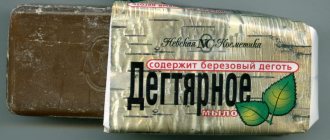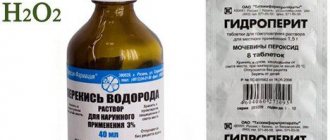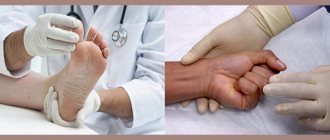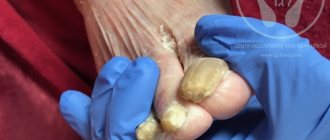To restore the health of the nail plate after a fungal infection or to cure sensitive epidermis, it is recommended to increase the effectiveness of manipulations. For this, home technologies are used - lotions, compresses, baths that have a beneficial effect on the state of the surface microflora.
Hydrogen peroxide can be used against toenail fungus, however, the drug has usage characteristics that should be taken into account when adding it to antifungal medication recipes.
Effect of peroxide on fungus
Hydrogen peroxide for the treatment of nail fungus
Treatment in this way allows you to significantly save on the purchase of expensive ointments and creams for mycosis, which are widely available in modern pharmacies. The composition of the drug is such that all existing microbes on the treated surface are quickly destroyed. Thus, the process of disinfection occurs, which is an integral part of the treatment of fungal infections.
The popularity of hydrogen peroxide is due not only to its low cost and good healing properties, it is also absolutely safe to use. As a rule, the drug is used as an auxiliary drug in the complex therapy of fungal infections. To avoid relapse of the disease, it is used as a prophylactic.
After the mycosis is cured, cleansing procedures with hydrogen peroxide should be carried out regularly. This will prevent re-infection.
About peroxide as a medicinal substance
Hydrogen peroxide is a disinfectant liquid that is used to treat minor damage to the integrity of the skin, as well as large wounds (for dressings) and during surgical interventions. This substance is produced by the body, moreover, it plays a vital role in many processes, in particular:
• participates in all reactions; • normalizes the functioning of the gastrointestinal tract; • helps normalize blood composition; • promotes vasodilation; • normalizes acid-base balance; • saturates tissues with oxygen; • promotes the destruction of toxic substances; • helps in the process of tissue regeneration; • participates in the fight against any infectious process.
Today, peroxide is used in both traditional and informal medicine. Available in liquid and dry form: 3% and 35% solution, and tablets. The 35% solution is used mainly by doctors in the USA. In our case, it would be more prudent and safer to use 3% perhydrol.
Contraindications for use
Using peroxide at different stages of fungus
Despite all the safety when using this drug, the drug has contraindications for use. This medication should not be used if a person has an individual intolerance or experiences allergic reactions when the skin is exposed to the composition.
In most cases, the patient may feel a slight burning sensation when applying the drug to an area of the body. This is absolutely normal and indicates that the product is working by actively fighting the infection.
When treating the surface of the nail, it is better not to touch the skin around the affected nail plate. This can lead to serious skin irritation.
Nail fungus: symptoms
The causative agents of nail fungus, or trichophytosis, are pathogenic dermatophyte fungi.
The disease can be recognized by the following signs:
- nail color changes;
- curvature and enlargement of the nail plate occurs;
- the nail plate crumbles and flakes;
- when pressing on the affected nail, slight pain is felt;
- the affected areas emit an unpleasant odor.
The disease does not develop immediately. It all starts with the appearance of stripes and small cracks on the nails. Soon the process spreads to unaffected areas. In each person, the development of the fungus occurs individually over a period of several months to several years.
Preparing for treatment
To achieve the maximum effect from treating nail fungus with hydrogen peroxide, you need to carry out a number of preparatory procedures. This will help soften the nail plate and prepare it for the effects of the drug.
To ensure contact of peroxide and the surface of the affected nail, the following manipulations are performed:
- Prepare a hot foot bath with copper sulfate.
The drug can be easily purchased at any nearby pharmacy. First, dilute the medicine in water at the rate of 1 tsp. for 1 liter of water. The composition is thoroughly mixed and only then added to the foot bath. Usually add 1 tbsp to 1.5 liters of water in the bath. copper sulfate solution.
- Place your feet in the bath and hold for about 15-20 minutes.
This time should be enough for the feet affected by the fungus to steam and the nail plate to become softer.
- Dry your feet.
After steaming, your feet should be thoroughly dried with massaging movements so that they are completely dry.
This completes the preparatory procedures and you can proceed directly to the use of hydrogen peroxide. The preparatory stage will not require a lot of time, but will ensure unhindered access of the medicine directly to the source of infection.
The preparation stage before the procedure should not be neglected. This can significantly reduce the therapeutic effect.
What to do?
First, you should find out how valid your fears are by visiting a dermatologist or mycologist. But in a busy schedule it is not always possible to find enough time for this, and a visit to the doctor has to be postponed. Meanwhile, the fungus is actively developing. People close to you and living with you are exposed to infection. Finally, not having found the time to go to the doctor, you decide to limit yourself to over-the-counter products. But when you come to the pharmacy, you understand that choosing what you need from a wide range of drugs is not so easy.
Not trusting the opinion of pharmacists or being afraid of high prices, you leave empty-handed. The problem remains unresolved. What to do? Let's remember how our grandparents treated themselves. We will treat the fungus with hydrogen peroxide.
Compresses
Before making a compress, you need to thoroughly steam your nails and cut the plate short. To do this, you can use hot baths with the addition of baking soda. Soda is taken at the rate of 1 tsp. for 2 liters of boiled water. Before using peroxide, your feet should be thoroughly dried with a soft towel.
For compresses, cotton swabs are moistened with a 3% hydrogen peroxide solution and applied to the affected nail. Keep the compress for at least 1 hour and repeat the procedure 3-4 times during the day.
It is important that the area of the tampon is equal to the area of the fungal infection. The result will be more effective if you place a film on top of the compress and insulate your finger.
The occurrence of pain and burning should be an alarm bell. In this case, the nail should be immediately rinsed with plenty of warm water and treatment should be abandoned in this way.
Peroxide compress
After completing the procedure, it is better to lubricate your nails with antifungal cream. A few days with compresses will soften the nail plate, making it accessible to medications prescribed by the doctor.
The use of compresses is one of the most accessible and simple means to get rid of an unpleasant disease. Making lotions is very simple and requires a minimal amount of money and time.
What other recipes are there?
Baths.
The simplest recipe for preparing a medicinal bath is to mix plain water and hydrogen peroxide. You need water at a temperature of about 40 degrees, to which add 2 tablespoons (for every liter) of the medicinal solution. The legs are held for 10 minutes or more, depending on the severity of the disease. Positive changes will be noticeable within 5 days, but treatment should not be stopped until complete recovery.
"Effervescent" liquid.
This unusual medicine is prepared as follows: 3% hydrogen peroxide and 3% vinegar are mixed in a ratio of 1 to 1 - the liquid is ready. Then it must be applied to the affected area and left until it stops hissing.
The next step is immersion in the bath. It must be prepared in advance. Add a small amount of laundry bleach to the water. After the activities described above, the feet are immersed in the bath. They remain there for 30 to 120 seconds, after which they are wiped dry with a towel.
The last is the treatment of the lower extremities with a substance obtained by mixing tea tree essential oil and Vaseline (in half) . Then you need to put on cotton socks. The procedure is repeated daily for a week.
Baths
An equally popular method of combating mycosis is a bath with the addition of this medicine. For cooking you need 1 liter of water and 2 tbsp. 3% peroxide solution.
Limbs infected with the fungus are placed in a container with the solution for about a quarter of an hour. After the bath, the affected part of the nail is easily removed with a nail file. To achieve maximum therapeutic effect, antifungal cream or ointment can be applied to soaked nails.
Before applying medicinal ointments immediately after a bath with hydrogen peroxide, nails should be thoroughly dried with a soft towel.
The procedure must be repeated daily, twice a day, for a month. The first results will be noticeable within 4-5 days. It is not necessary to keep your nails in the bath continuously; it is enough to lower them there for 30 seconds and then pull them out. And then lower the affected nails into the bath again.
Use in children, pregnant and lactating women
External use of 3% hydrogen peroxide is not contraindicated in childhood and for women preparing to become mothers. When applied topically, the drug is not absorbed into the general bloodstream, does not reach the fetus through the placental barrier and does not pass into breast milk. Therefore, peroxide in the form of lotions and compresses can be a real salvation for women who are temporarily unable to use serious antifungal medications due to pregnancy and lactation.
The only thing undesirable for expectant mothers is hot foot baths. High temperatures can cause a rush of blood to the pelvic organs and provoke contractions, which can lead to complications such as spontaneous miscarriage or premature onset of labor.
Recipe with vinegar
Lotions with vinegar
Lotions with vinegar are considered an effective remedy for fungus. The ingredients are mixed in equal proportions. After this, the composition is applied to the affected nails and left until the active reaction between the components ends.
Then the nails should be thoroughly rinsed under running water and dried with a towel or soft cloth. The duration of such treatment should be at least 1 week with daily procedures.
Prevention of onychomycosis
First of all, in order not to become infected with nail fungus, it is necessary not to create favorable conditions for the proliferation of its spores. This can be avoided by following just two very important rules:
- It is constantly necessary to carry out thorough hygiene procedures, monitoring the condition of the nails and skin of the feet;
- You should change your socks frequently as needed.
If it was not possible to avoid the development of nail fungus, it is very important to minimize the consequences that it can lead to. This is also easy to do by following fairly simple but very effective prevention steps:
- It is necessary to change old, uncomfortable and worn-out shoes;
- All boots, sneakers and shoes should be treated with antiseptic agents;
- You must always walk in places with an increased risk of infection (baths, saunas, beaches, etc.) in special washable slippers;
- You should regularly carry out wet cleaning at home, using Furacilin tablets in the washing water.
By following all the rules for preventing fungal infection, you can avoid not only the spread of this disease, but also the disease itself. In addition, the cured nail should not be re-exposed to danger, so after therapy you should also adhere to these recommendations.
Recipe with baking soda and salt
Sea salt and baking soda have been used to treat nail fungus for decades. Lotions are prepared from a quarter cup of peroxide, 0.5 cups of salt and two cups of soda slaked with vinegar. Having received the solution, a cotton swab is dipped into it, which is then secured to the nails affected by the fungal infection. You need to keep the lotions for at least 1 hour. The procedure should be repeated every 10 hours.
It may take at least 1 month to completely cure the infection using this method. Everything is purely individual and depends on the patient’s immunity and the degree of damage to the nail plate.
What can you replace hydrogen peroxide with?
Among folk remedies, there are many drugs that have a pronounced antifungal effect. Let's look at what can replace peroxide.
Tea tree oil. Its active components - terpienes, sabinenes, pinenes and phellandrenes help destroy dermatophytes and candidiasis pathogens. The product can be used independently to treat affected nail plates, or in combination with other medicinal products.
Iodine. A powerful antiseptic that destroys all known types of fungus. The drug stimulates the coagulation of protein fractions, which make up pathogenic microorganisms, that is, it kills the causative agents of onychomycosis at the cellular level.
Propolis. A strong fungicidal and bactericidal agent that not only destroys fungal flora, but also helps eliminate the symptoms of the disease.
Preparation of ointment with hydroperite
Ointment with hydroperite
Hydroperite tablets can be mixed with petroleum jelly, thus obtaining an ointment for the treatment of mycosis. The tableted product must be crushed to a powder.
The ointment is applied to the affected nails in a thick layer and secured with a cotton swab and adhesive tape. Keep the compress with ointment for at least 1 hour. The nails are then left open for a while to expose them to oxygen. This is necessary for a speedy recovery.
It is important to understand that regularity of procedures allows you to achieve a therapeutic effect much faster. If not observed regularly, the disease may return again and again.
The prepared ointment is stored in the refrigerator in a tightly closed jar. The procedure should be repeated daily 2-3 times a day.
Description and medicinal properties
This substance is one of the simplest representatives of peroxides. It looks like a clear liquid and has a characteristic “metallic” taste, is highly soluble in alcohol, water or ether and is itself a strong solvent.
In medicine, hydrogen peroxide is an antiseptic with a noticeable softening effect. When placed on the affected areas of the skin, a foam appears, separating dead cells and making the nail plate softer. As a result, the damage is cleansed and disinfected, but even a significant amount of peroxide is not able to completely kill the fungus and its spores. For this reason, it is inadmissible to call this method a full-fledged means of control; it is effective solely as an addition to complex treatment.
Since peroxide, despite its basic disinfecting properties, takes part in other body processes, in the field of traditional medicine it is used in the complex treatment of many diseases.
Treatment according to Neumyvakin
Professor Neumyvakin is confident that treatment with hydrogen peroxide will help get rid of not only nail fungus, but also psoriasis, warts, Parkinson’s disease and other pathologies. He offers not only external use of the solution, but also its oral administration.
Treatment of fungus according to Neumyvakin
Before use, nails should also be prepared for upcoming procedures. To do this, they are steamed in a bath. Then you need to soak cotton swabs in a 3% solution of hydrogen peroxide and apply to the infected nails. The lotions can be covered with polyethylene and secured with adhesive tape. The compress is left for 30-40 minutes.
After removing the lotion, the overgrown and softened nails are carefully cut off with nail scissors. A file can be used to remove softened parts infected with fungus. Then an antifungal cream, prescribed by the attending physician, is applied to the nails and the entire foot.
Lotions should be done every time before using the medicinal ointment. This will allow you to achieve a therapeutic effect much faster. Already on days 4-5 the first improvements will be noticeable.
What to do to prevent re-infection?
Onychomycosis is an insidious pathology that can return at any time. In this regard, it is necessary to take preventive measures, namely:
• disinfect all shoes; • change socks daily, wear only clean ones; • carry out foot hygiene every evening, take preventive baths regularly; • if the disease constantly recurs, use antifungal ointments or creams. • if onychomycosis “occurs” again, do not delay, but immediately begin therapy, because treating an advanced form of nail fungus with hydrogen peroxide is much more difficult than the initial one.
Prophylactic use of peroxide
Curing a fungus does not mean getting rid of it forever. To avoid recurrence of the disease, personal hygiene and preventive procedures are important. An antiseptic will help prevent the return of an unpleasant disease.
To prevent nail fungus, use baths with the addition of a 3% peroxide solution. To prepare the solution, take 2 tablespoons of vinegar and peroxide per 1 liter of warm water. Place the feet or hands affected by the fungus into the resulting solution and hold for 15 minutes.
Numerous positive reviews about hydrogen peroxide, as an excellent means of fighting fungus as part of complex therapy, can be easily found on the Internet. Many people who have been struggling with fungal nail infections for a long time were amazed at the effect obtained from using baths and lotions with an antiseptic.
The use of hydrogen peroxide is completely justified and has been proven by the positive results of complex treatment. The effect of the main therapy occurs much faster, itching and pain disappear in just a few days. In addition, this tool is quite accessible to anyone.
The principle of action of the remedy for onychomycosis
Peroxide contains only two types of molecules in its chemical formula - hydrogen and oxygen. It is distinguished from water or H2O by a single oxygen atom. Scientifically, the substance is called peroxide. In medicine, the product is used to treat wounds, burns and other skin lesions for disinfecting purposes.
The use of peroxide in the fight against nail fungus is explained by its disinfectant and antibacterial properties. The drug destroys pathogenic microflora, stimulates the regenerative functions of damaged tissues, and prevents the addition of a secondary infection.
The method of treating onychomycosis with hydrogen peroxide is gentle, effective and affordable, provided that we are not talking about an advanced form of the pathological process. Let's look at what recipes exist based on this medication, but let's start with the preparatory procedures.
Indications
Indications for the use of hydrogen peroxide include all open and purulent wounds, preventive disinfection and other tissue damage. If you soak a bandage in a peroxide solution, it will be much easier to remove the bandages from the injury. When applying the product to an open wound, foam begins to form, which means cleansing of pus.
Hydrogen peroxide for nail fungus is used in two cases:
- As a preparatory step before applying external antifungal agents.
- In the first stages of onychomycosis, since the disease is advanced, you need to stop self-medication and consult a specialist.
Reviews
- Anastasia, 42 years old : “Before going on vacation, I encountered the problem of being flexible on my legs. I decided to use an effective ointment that was offered to me at the pharmacy, but it did not help me. Then I started looking for the necessary information on the Internet. I learned that fungus can be treated with a remedy such as hydrogen peroxide. I made baths adding this drug. After just a week of active treatment, the position of my nails has noticeably improved. Only after the procedure did I apply antifungal cream.”
- Antonina, 46 years old: “Hydrogen peroxide is my favorite and proven remedy for fungus. As soon as my husband had the first manifestations of a fungal disease, he immediately began treatment with this miracle remedy. Within a week, the disease had subsided, and there was not a trace of the fungus.”
- Andrey, 23 years old: “I never thought that I would have fungus. But when the disease overtook me, I was advised to use a remedy such as hydrogen peroxide. I didn’t really believe in its healing properties right away, but I had no choice, because I wanted to get rid of the fungus as quickly as possible. I simply rubbed a few drops of this product into the damaged nail and after 6 days the disease went away. From now on, hydrogen peroxide will always be in my first aid kit.”
Hydrogen peroxide is a great opportunity to quickly and inexpensively cure fungus on your hands and nails. To do this, you can use two options - baths or compresses. The effectiveness of this therapy method is quite high, so you can cope even with a fungus that is in an advanced stage. How to treat fingernail fungus and what medications are best to use can be found in this material.
Professor Neumyvakin
Known for his research in the field of traditional medicine, Professor Neumyvakin spent many years studying the properties of hydrogen peroxide, its effect on the body and treatment possibilities. He found that this chemical could help fight a huge number of different diseases. The doctor believes that peroxide to treat nail fungus can be used not only externally, as we used to think, but also internally.
You should not be afraid of this method of treatment, since its safety has been tested several times, including by Professor Neumyvakin himself, but you need to be sure that there are no personal contraindications or intolerances.
The doctor wrote a book about how to properly fight fungus, “Hydrogen Peroxide. Myths and Reality”, as well as many lectures and instructions that can be found on the Internet.
Paste
It is possible to cure the fungus with folk remedies, but only on condition that the infection has just begun to develop:
- Take 1 tsp. baking soda and salt, add 4 tsp. water and 1 tsp. hydrogen peroxide. Distribute the paste evenly over areas affected by onychomycosis. Place polyethylene on top and secure everything with a bandage. The paste should be washed off after 40 minutes. Dry your nails thoroughly. The procedure should be carried out daily for a month.
- Make a powder from six tablets of hydroperite (the drug contains 35% peroxide), add the same amount of Vaseline to it. Apply the paste to infected horny plates 3 times a day and leave until absorbed. The course of treatment lasts until the stratum corneum of the fingers is renewed.
Kitchen salt and soda help stop onychomycosis due to the formation of an aggressive alkaline environment. Destroying the infection, they at the same time heal painful cracks in the skin of the fingers, relieve itching and eliminate unpleasant odor.
Why does the wound hiss when applying peroxide?
The first step in providing medical care to the victim is to treat the damaged area of skin, which is most often done using a peroxide solution. From its interaction with the damaged skin, a reaction occurs - hydrogen peroxide foams and hisses on the wound.
As a result of mechanical impact (fall, blow, cut), the skin is torn and blood appears on the surface. Its cells contain a special enzyme - catalase, which, when the cellular structure is damaged, comes out in large quantities. When peroxide comes into contact with natural protein, which acts as a catalyst, the drug quickly decomposes into oxygen and hydrogen. The liquid heats up on the wound, and the oxygen released as a result of an active chemical reaction is “immersed” in the water, forming bubbles. They are the ones that foam and turn white. At the same time, you can hear a characteristic hissing sound.
The wound is intensively cleansed of harmful bacteria. This occurs due to intense foaming. Microorganisms contain the enzyme catalase, which comes into contact with the antiseptic.
Doctors do not recommend using peroxide oxidizer on an ongoing basis as a universal antiseptic drug. This is due to the fact that peroxide and its foaming significantly slow down the processes of contraction and healing of wounds, especially open and deep ones.











